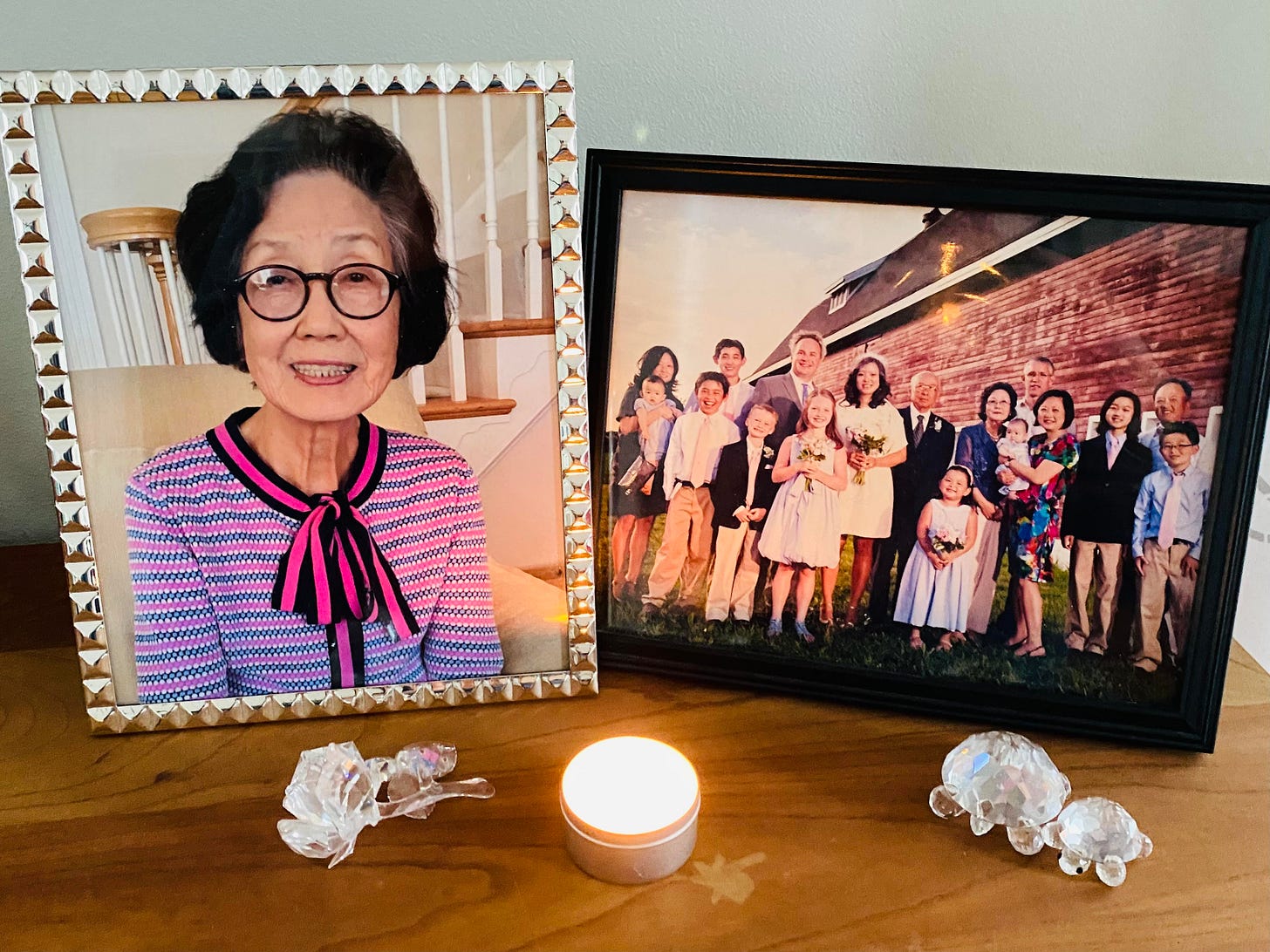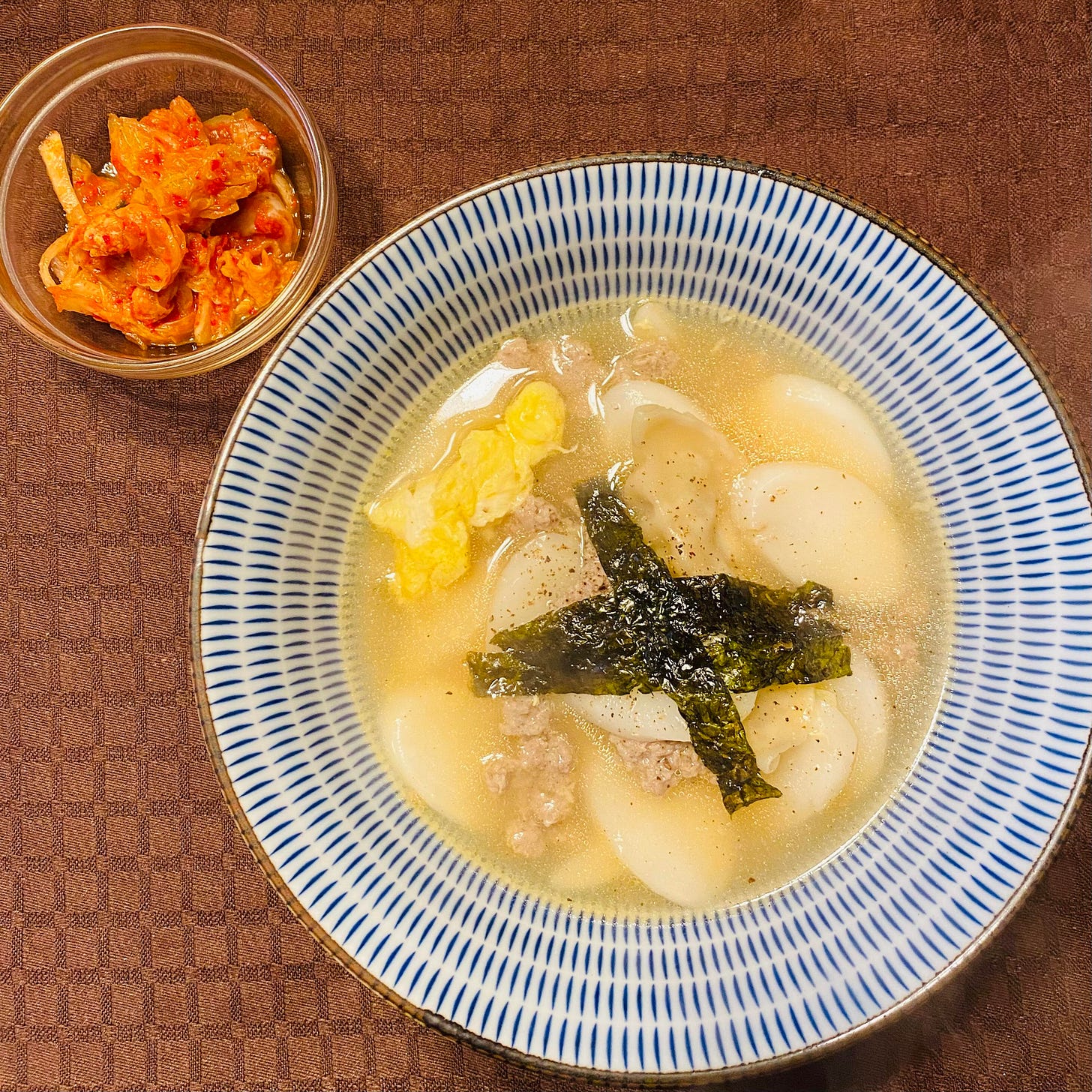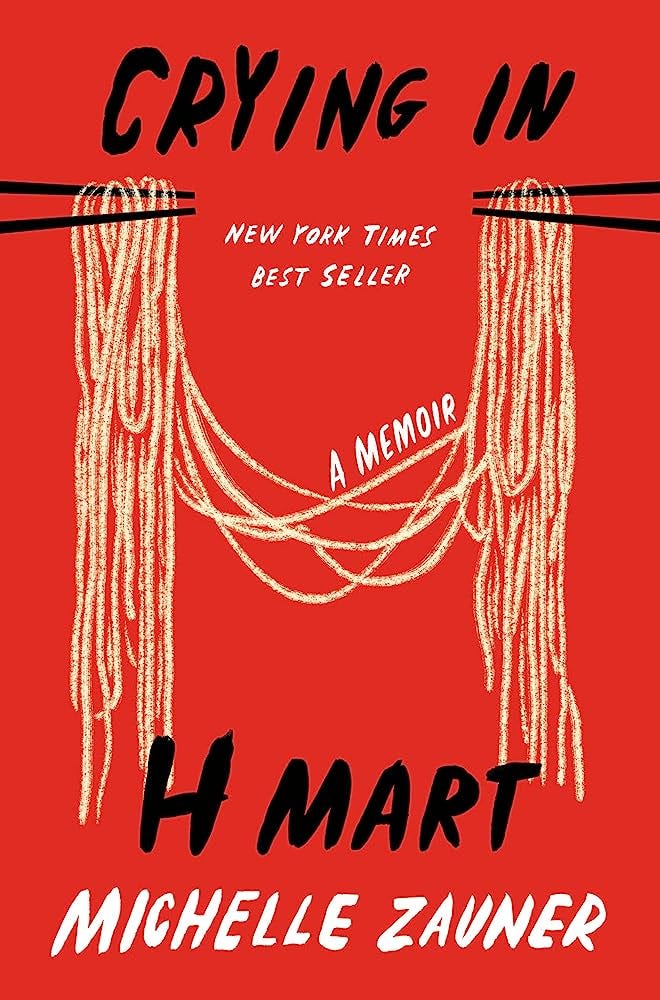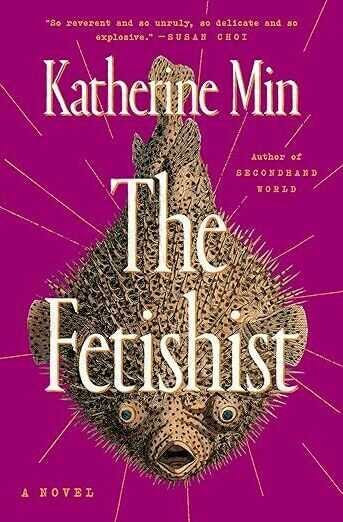Welcome to Hello Lucky!, my newsletter for people who love food, books, and living their best life. Every month, I’ll feature a recipe, book recommendations, and personal story that I hope will resonate and maybe brighten your day. And yes, the newsletter is named for my dog Lucky because he brightens every day for me.
New Year Traditions
Happy belated new year -- or early new year if you go by the lunar calendar. January 1 is the anniversary of my mother’s death, so this season is bittersweet for me. This year, to honor Mom’s memory, I set out photos of her and lit a candle and made a pot of duk guk (rice cake soup) – the ultimate Korean comfort food.
It’s Korean tradition to have duk guk on New Year’s Day. Some say the oval shape of the sliced rice cake is reminiscent of ancient Korean coins; others say the clean, white color symbolizes a fresh start. Whatever the reason, eating a bowl of duk guk on New Year’s is supposed to bring good luck. Also, in a weird quirk of how Koreans used to determine age, it also added a year to every one’s life.
There are so many things I miss about Mom, but her Korean cooking is way up there. Like many immigrant women, my mom was an intuitive cook, adding a pinch here, a dash there, tasting as she went along. Once I started my own family, I asked for her Korean recipes, but she waved me off. “You’re a career woman,” my mom said. “Making Korean food is too much work. Go out to a restaurant if you want it.”
Whenever I tried making Korean food at home, I was almost always disappointed. My kimchi jjigae lacked umami, my kalbi-jim wasn’t tender enough, my kimbap fell apart. Mom was right: it was a lot of work, and nothing ever tasted as good as her home cooking.
Now that my mother is gone, I’ve been braver about trying my hand at Korean cooking. My repertoire is limited, but it’s continually growing. It helps that there are now so many more resources – popular cookbooks like Eric Kim’s Korean American and Joanne Lee Molinaro’s The Korean Vegan, user-friendly recipe websites like maangchi.com, koreanbapsang.com, and mykoreankitchen.com, not to mention the fact that many Korean ingredients are now widely available at supermarkets and Trader Joe’s.
The big “aha moment” for me came when I realized I don’t need to reproduce my mother’s cooking; I could just try to capture the overall taste. For example, Mom spent days making duk guk broth from scratch: boiling the beef, letting the broth cool overnight and skimming the fat from the surface, shredding and marinating the tender meat. I found I could obtain the same flavor profile in a fraction of the time by stir-frying marinated ground meat and adding bonito soup powder. And instead of the fine juliennes of yellow and white egg omelet that my mom used to garnish each bowl, I just pour whisked egg into the hot broth and let it bloom like egg drop soup.
Purists may scream, “Ay, cham!” in horror, but I don’t care. I’m just happy to enjoy my bowl of duk guk whenever I want to remember the flavor of my mother’s love.
Quick and Easy Duk Guk (Korean Rice Cake Soup)
Serves 2-4
Ingredients
10 oz. (about one cup) duk (sliced rice cake)
4 oz. ground turkey or beef
2 cloves garlic, minced
1 tsp. sugar
1 Tbsp. soy sauce
Splash of sesame oil
Fresh black pepper, to taste
Roasted sesame seeds (opt.)
1 tsp. cooking oil (I use canola)
3 cups water
1 tsp. dashi powder (bonito soup base)
1 egg, lightly beaten
Optional: 4-6 frozen mandu (dumplings); minced green onion (for garnish); roasted and salted seaweed (for garnish)
Instructions
1. Soak sliced rice cakes in water to soften.
2. In measuring cup, whisk together garlic, sugar, soy cause, sesame oil, black pepper and dash of sesame seeds (optional).
3. Add meat to garlic-soy marinade and combine until well-mixed.
4. In medium saucepan, heat cooking oil. Add marinated meat and sauté until meat loses its pink color and renders its juices.
5. Add water and dashi powder to saucepan; cover and wait for contents to boil.
6. Drain rice cakes and add to saucepan. (If using dumplings, add them now too.)
7. Cover saucepan and wait for contents to return to boil. Be careful broth doesn’t boil over. Once rice cakes and dumplings float to the surface, they are done.
8. Add beaten egg to saucepan and cover again. After a minute or so, the egg should bloom like egg drop soup.
9. Ladle soup into bowls while piping hot.
10. Garnish with minced green onion and roasted seaweed (cut into slivers or crumbled), if desired.
Lucky Tip: My husband used to hate duk guk because Beginner Mom Me overcooked the rice cakes so they turned gluey. Think of rice cakes as pasta: you want them cooked but not mushy. Duk guk is best when it’s freshly made. If you have leftovers, I recommend separating the duk and dumplings from the broth before storing and refrigerating so that they don’t absorb all the liquid.
Reading Recommendations
“Am I even Korean anymore if there’s no one left in my life to call and ask which brand of seaweed we used to buy?” Michelle Zauner asked in her viral New Yorker article, “Crying in H Mart,” and her NYT best-selling memoir of the same title. In both, Zauner explores feelings of grief, love, and loss of identity following the death by cancer of her Korean mother. When I first read the book in 2021, my own mother was in the early stages of dementia, and I was going through a period of anticipatory loss and grief myself. Now that it’s been a couple years since my mom’s passing, I feel like it might be time for me to revisit Zauner’s book to see if it resonates differently.
Two books on my to be read (TBR) pile are I Would Meet You Anywhere by my friend Susan Kiyo Ito, and The Fetishist by Katherine Min (edited by her daughter Kayla Min Andrews). Both are testaments to the power of love between mother and daughter.
Growing up with adoptive nisei parents, Susan Kiyo Ito knew only that her birth mother was Japanese and her father white. Many years in the researching and writing, I Would Meet You Anywhere chronicles Susan’s search for answers, history, and identity. A “stunning, brave, extraordinary book,” according to Library Journal’s starred review.
Katherine Min was a celebrated author and beloved teacher when she died of breast cancer in 2019, leaving her second novel uncompleted. Katherine’s daughter Kayla Min Andrews worked with famed editor Sally Kim to bring her mother’s final work, The Fetishist, into the world. It is “truly a labor of love and a joy to read,” raves the SF Chronicle. (Fun fact: Katherine’s mother and my mother were classmates in Korea and BFFs here in the US.)
I hope you enjoyed this first installment of Hello Lucky! Please share, comment, or ask me anything. I could use all the encouragement and ideas I can get!
XO Ann










Great Start!